Peplum Populist: The Colossus of Rhodes (1961)
The Colossus of Rhodes may be my personal favorite Italian sword-and-sandal (peplum) film. This one has everything: epic scope, gigantic ornate sets, devious espionage fun, bizarre gizmos, numerous brawls and sword fights, amphitheater challenges, secret passages, a sadistic torture chamber, a dungeon with lions, ceremonial dances, an evil temple, a femme fatale, an earthquake, a slave uprising, copious practical special effects, a gratuitous ape costume, and the insane super-weapon statue at its center. The only thing it doesn’t have is a muscleman hero. But it has the best possible substitute: one of the all-time great directors of world cinema, Sergio Leone. A guy with director muscles to rival Steve Reeves’s actual muscles.
Before you get too excited, I must explain that The Colossus of Rhodes (Il Colosso di Rhodi) is the seventh best of the seven movies with Leone as the credited director. However, the other six are A Fistful of Dollars, For a Few Dollars More, The Good, The Bad and the Ugly, Once Upon a Time in the West, Duck, You Sucker!, and Once Upon a Time in America. No shame coming in seventh to that bunch. The Colossus of Rhodes isn’t a baroque masterpiece, but it’s a solid neo-classical success.
In 1961, Sergio Leone already knew more about how to put together an exciting film than most first-time directors. He had collected almost a decade and a half of experience as an assistant director in Rome, working on Hollywood films like Quo Vadis, Helen of Troy, and Ben-Hur. He directed (without credit) the Italian epic The Last Days of Pompeii when its original director became ill after one day of shooting. Leone considered directing The Colossus of Rhodes the end of his long apprenticeship in film. He made the movie in the conventional studio style of the time, and then he dashed off to create his own style.
The script for Colossus, credited to Leone and three earlier writers, uses a standard blueprint peplum narrative with a few tweaks. It takes place in the Hellenistic Age rather than the mythical Bronze Age or the Roman Empire, which were the favored time periods for sword-and-sandal. The setting is the island of Rhodes after the completion of the newest Wonder of the World, a three hundred and sixty-foot-tall bronze statue straddling the harbor mouth. (The historical Colossus didn’t straddle the harbor and was probably around a hundred feet tall. The movie follows the fanciful imaginings of later artists.) The king of Rhodes, Serse (Roberto Camardiel), constructed the Colossus using forced labor from the locals. A rebellion under Peliocles (French actor Georges Marchal, a favorite of director Luis Buñel) plans to end Serse’s tyrannical reign. But there’s another plot brewing against the king. Serse’s minister Thar (Conrado San Martín) has arranged a shady deal between Rhodes and Phoenician pirates to raid Greek ships. But Thar is actually planning a coup to seize the throne of Rhodes using Phoenician soldiers smuggled onto the island in the guise of slaves and hidden in chambers under the Colossus.
The plot sounds overstuffed with competing revolutions — the good-hearted freedom fighters and the scheming no-gooders from the Middle East — as well as a surplus of characters. This is the standard sword-and-sandal movie convolutions resulting from having too many writers working with too little time. But The Colossus of Rhodes gives its Byzantine story space to breathe. (Is it okay to use Byzantine as an adjective in a movie about the ancient world? Or does that sound confusing?) A running time of over two hours is normally a bad sign for this type of light entertainment, but Leone paces the story so the plotting isn’t (too) bewildering or plagued by a jarring compression of events. The set-pieces parade past furiously after the leisurely first half-hour, so there’s little chance to get bored once the movie hooks you in.
And the main hook is an excellent one: the innocent outsider who stumbles into a web of deadly espionage. Dario (Rory Calhoun) is a Greek general paying a visit to Rhodes to see his uncle, eat grapes, drink wine, and watch the dancing girls. Dario’s vacation turns risky when he starts romancing Diala (Lea Massari), the daughter of the engineer of the Colossus, and both the rebels and the king’s agents target him for their own reasons. Dario tries to cut his way out of the tangle after getting rough-housed, but becomes permanently ensnared in the rebellion when he’s caught aboard a boat with Peliocles and his band. Using Dario’s outsider POV helps to introduce the various factions and their plottings gradually.
The featured star is one of Colossus’s departures from the peplum formula. Instead of a bodybuilder, an actual Hollywood leading man heads up the cast. Rory Calhoun, who took over the role of Dario at the last minute when actor John Derek clashed with Leone, wasn’t at the pinnacle of the Hollywood star system, but he was a name in B-Westerns with a long list of credits and a few supporting roles in A-pictures like How to Marry a Millionaire (1953) and River of No Return (1954). Instead of brawn, Calhoun brings to The Colossus of Rhodes delightful Westerner charm and Hollywood studio slickness. He dubs his own voice (extremely rare in pepla) and appears delighted to be on set. It’s uncanny to see this flavor of American performance in a European sword-and-sandal film; it’s like having a cost-effective Clark Gable in a Hercules flick. But it works! Rory Calhoun’s smooth midwesterner attitude sets Dario apart from the Rhodians, emphasizing his role as the jaunty outsider who knows nothing about the politics of the situation and would rather not find out — until he has no choice.
It’s unfortunate that Calhoun’s love interest doesn’t hold up as well. Lea Massari (who disconcertingly resembles Jennifer Lawrence) has the presence to play the duplicitous and complicated part of Diala — but she can’t handle acting duplicitous and complicated parts. Massari isn’t able to turn on the seductress part in her scenes with Calhoun, nor is she imposing when revealed as a villainess. Not surprisingly, the actress never returned to the sword-and-sandal genre.
Dario has a backup romance with a woman in the rebellion, Mirte (Mabel Karr) the sister of Peliocles, but this love story hardly registers because Mirte is a flimsy character with minimal screen time. I’d rather the film didn’t bother with poking around in the supporting cast to scrounge up somebody for Dario to ride off with at the end.
By Leone’s own admission, the biggest Hollywood influence on The Colossus of Rhodes is Alfred Hitchcock. Dario’s character is an obvious version of the “wrong man” hero who appeared in Hitchcock’s classics like North by Northwest and The 39 Steps. The Hitchcock comparison becomes impossible to miss when a swordfight is staged on top of the Colossus. This is a direct reference to Saboteur (1942) and its vertiginous climax atop the Statue of Liberty. This isn’t the only link the movie makes between Lady Liberty and the Colossus. Leone purposely inverts the meaning of the Statue of Liberty: instead of welcoming visitors from other lands at the mouth of the harbor, the Colossus is there to block the harbor and imprison people. You can feel Leone having a blast twisting an American icon and getting to do a Hitchcock suspense scene all at once.
Leone’s immense love for the American Western also makes appearances. The final shot of mountains and a train of Rhodians riding horses into a canyon is identical to the close of a Cinemascope Western, just with tunics instead of dusters. The strange rock formations where the rebels are hiding create a John Ford Monument Valley aura. (If you’ve seen The Valley of Gwangi or Conan the Barbarian, you’ll immediately recognize the shooting location.)
Although the direction is mostly straightforward without Leone’s tics and obsessions, some of his stylistic trademarks are already evident. He allows some scenes to play out with long dolly shots, such as the camera tracking with Dario as he walks through catacombs observing the mummies. This type of careful shot planning is uncommon in the often rushed shooting schedules of peplum films, but Leone already had the studious visual sense that evolved into intricate masterworks like the final duel in Once Upon a Time in the West and time-crossing jumps in Once Upon a Time in America.
The Colossus is a stupendous, ridiculous piece of “Leverpunk.” No mere background prop like Vesuvius in The Last Day of Pompeii, the statue is a super-weapon at the center of the villain’s plan. It can drop boiling oil from the chalice in its hands to destroy ships underneath. The top of the head folds open, creating a Statue of Liberty-style crown, to hurl out fiery projectiles at anyone attacking the area around the feet. The hollow head is a control room full of gears that would look appropriate as the headquarters for the Clock King in Batman ‘66. All the special effects tricks of the time are called into service to create the Colossus: full-sized props of a bust of the statue and the lower legs, a variety of miniatures, and matte paintings. In general, the VFX of the film are superb: the earthquake finale has more tumbling walls and mayhem than The Last Days of Pompeii’s volcanic send-off.
The scenes around the Colossus are the highlights in a film jammed with bonkers set pieces. The lengthy arena sequence starts with a chariot fitted with blades on its wheels challenging prisoners to try to jump over it or get their legs thwacked off. Then a rebel leader (genre staple Mimmo Palmara) is dangled over a pit of lions while an archer fires arrows at the ropes holding him up. The arena then shifts into a battlefield as the Phoenicians start their coup and fire volleys of arrows into the stands. In any other peplum film, this sequence would be the topper. But it’s only one of many memorable scenes in The Colossus of Rhodes, a movie that also has a torture chamber with a giant bell placed over victims and gonged repeatedly until their eardrums burst.
It’s all over-the-top, but Leone holds the crazy quilt together. The movie not only stays on course, it feels pretty darn classy. The stupendous sets, some of the best made in Italy at the time (the Phoenician temple is gorgeous), help make the mid-budget flick feel gloriously expensive. For once, the poster art doesn’t exaggerate what audiences will get for the price of admission.
The Colossus of Rhodes has thankfully received the Warner Archive treatment: a DVD release in anamorphic widescreen from a decent print. The current MOD-DVD is identical to the pressed DVD Warner Bros. Home Video released as part of a three-movie collection with Howard Hawks’s Land of the Pharaohs and the awful The Prodigal (both 1955). The disc contains a commentary track from Sergio Leone biographer Sir Christopher Frayling that’s an entertaining chaser to the film. If you’re a fan of Leone and/or sword-and-sandal films, this is a must-have disc. I rarely recommend a blind buy. Blind buy this.
By the way, it’s a pleasure to have the word Colossus appear in a sword-and-sandal movie title where it’s not a clumsy pseudonym for the hero — i.e. “yet another Maciste film.” This confused one of the Spanish producers, who kept asking Leone who was going to play the Colossus. He couldn’t understand the answer that it was actually a statue.
Ryan Harvey is one of the original bloggers for Black Gate, starting in 2008. He received the Writers of the Future Award for his short story “An Acolyte of Black Spires,” and his stories “The Sorrowless Thief” and “Stand at Dubun-Geb” are available in Black Gate online fiction. A further Ahn-Tarqa adventure, “Farewell to Tyrn”, is available as an e-book. His most recent publication, “The Invasion Will Be Alphabetized,” is now on sale in Stupendous Stories #19. Ryan lives in Costa Mesa, California where he works as a marketing writer. Occasionally, people ask him to talk about Edgar Rice Burroughs or Godzilla in interviews.
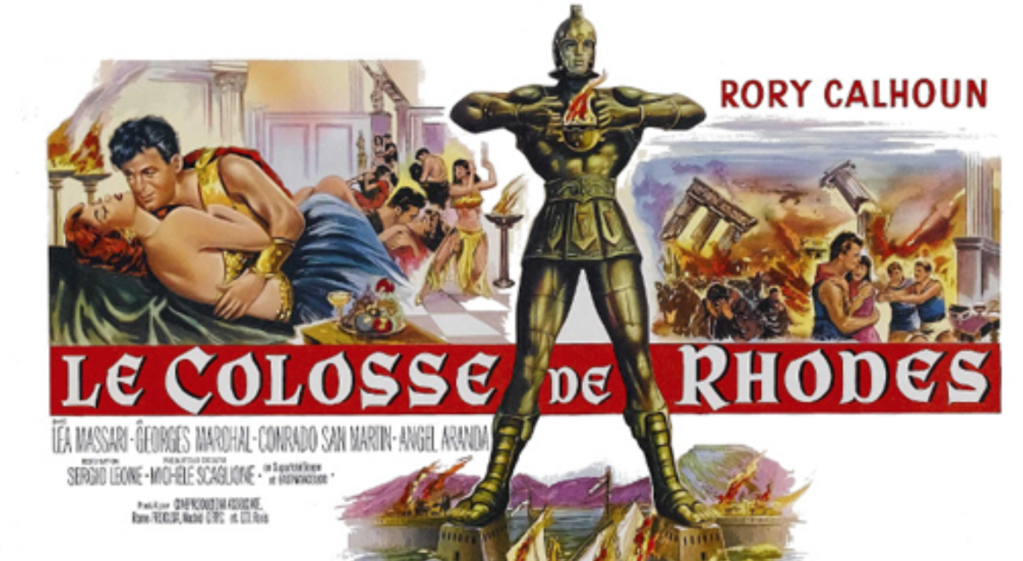
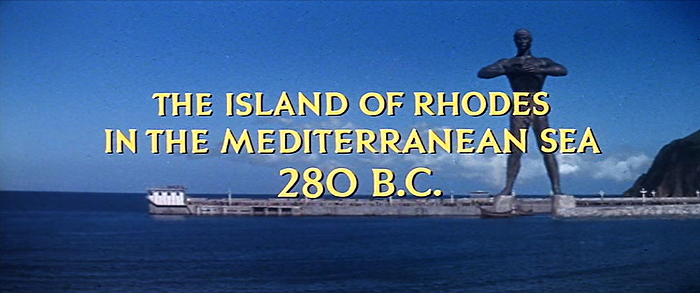
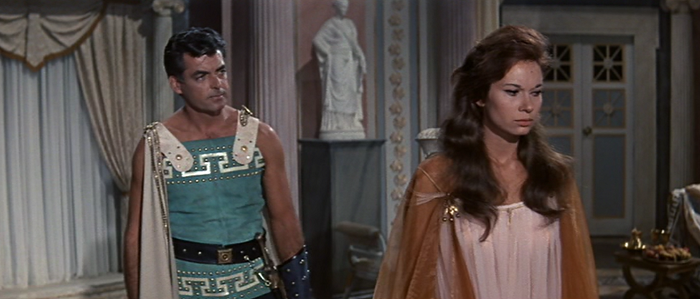
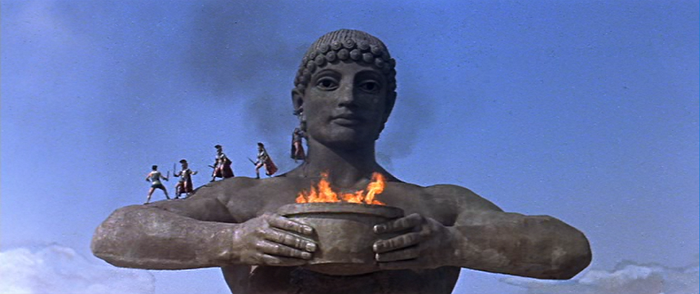
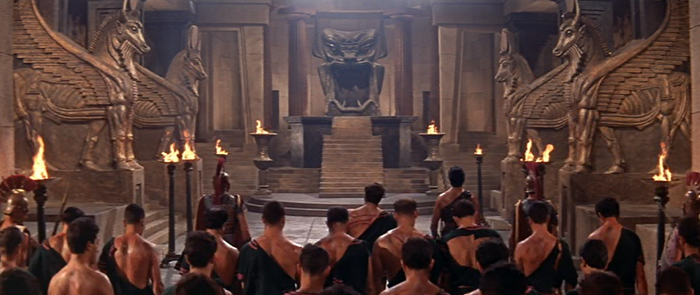
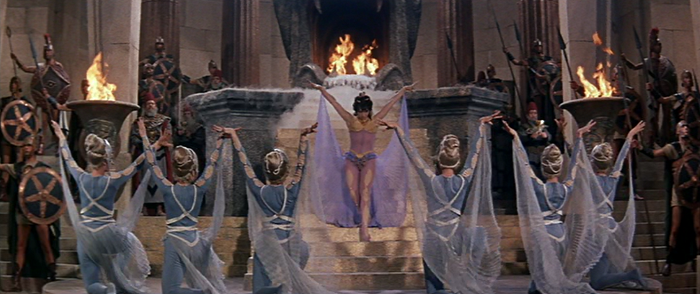
Added to my Netflix queue. (Yes, I still have them send me plastic discs in the mail.)
This is also available on Amazon Prime.